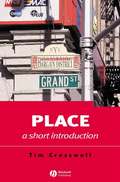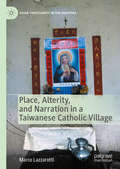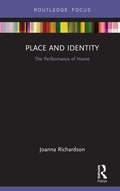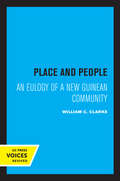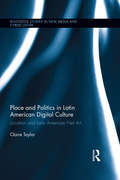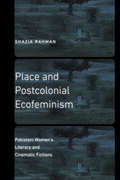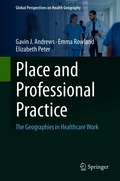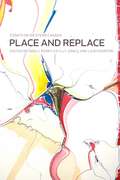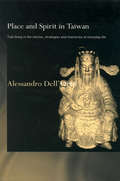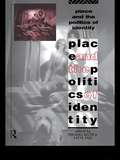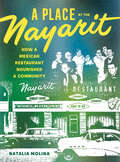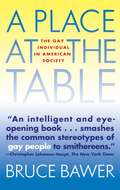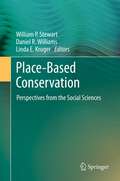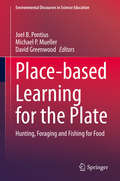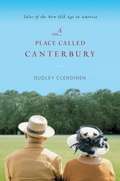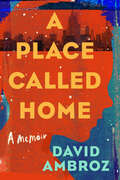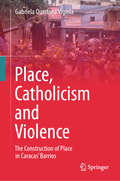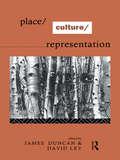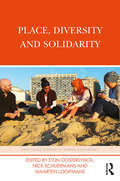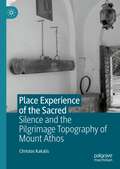- Table View
- List View
Place: A Short Introduction (Short Introductions to Geography)
by Tim CresswellThis text introduces students of human geography to the fundamental concept of place, marrying everyday uses of the term with the complex theoretical debates that have grown up around it. A short introduction to one of the most fundamental concepts in human geography Marries everyday uses of the term "place" with the more complex theoretical debates that have grown up around it Makes the debates intelligible to students, using familiar stories as a way into more abstract ideas Excerpts and discusses key papers on place by Doreen Massey and David Harvey Considers empirical examples of ways in which the concept of place has been used in research Teaching and learning aids include an annotated bibliography, lists of key readings and texts, a survey of web resources, suggested pedagogical resources and possible student projects
Place: An Introduction (Short Introductions To Geography Ser.)
by Tim CresswellThoroughly revised and updated, this text introduces students of human geography and allied disciplines to the fundamental concept of place, combining discussion about everyday uses of the term with the complex theoretical debates that have grown up around it. • A thoroughly revised and updated edition of this highly successful short introduction to place • Features a new chapter on the use of place in non-geographical arenas, such as in ecological theory, art theory and practice, philosophy, and social theory • Combines discussion about everyday uses of the term ‘place’ with the more complex theoretical debates that have grown up around it • Uses familiar stories drawn from the news, popular culture, and everyday life as a way to explain abstract ideas and debates • Traces the development of the concept from the 1950s through its subsequent appropriation by cultural geographers, and the linking of place to politics
A Place Against Time: Land and Environment in the Papua New Guinea Highlands (Studies in Environmental Anthropology #Vol. 1)
by Paul SillitoeA Place Against Time is an ethnographically focused environmental study of Montane, New Guinea, where people were among the world's first to cultivate crops some ten millennia ago, and where today an enduring agricultural condition continues. It arranges its account of climate, vegetation topography and geology according to their relationship with the soils of the region occupied by Wola speakers in the Southern Highlands Province of Papua New Guinea, in the Western Pacific. This book breaks new intellectual ground as an ethno-environmental investigation with a soils perspective, ethno-pedology being a little researched topic to date.
Place, Alterity, and Narration in a Taiwanese Catholic Village (Asian Christianity in the Diaspora)
by Marco LazzarottiThis book introduces a simple idea: when we tell a story, we tell a story and at the same time create the world where this story takes place. Narration creates environments, spaces and, in a certain sense, gives symbolic meanings and values to the identities by which people interact in their daily experiences. Set in the multicultural and multireligious Taiwanese environment, this book describes the interactions, and above all the narrations, linked to a Catholic village located in the Taiwanese countryside. Catholicism in Taiwan is a minor religion (around 2% of the population), and considered a foreign and heterodox religion, something different and "other" from the Taiwanese mainstream religious environment. It is this sense of alterity that creates the stories about this place and, as a consequence, creates this place and its special identity.
Place and Identity: The Performance of Home (Routledge Focus on Housing and Philosophy)
by Joanna RichardsonThe UK is experiencing a housing crisis unlike any other. Homelessness is on the increase and more people are at the mercy of landlords due to unaffordable housing. Place and Identity: Home as Performance highlights that the meaning of home is not just found within the bricks and mortar; it is constructed from the network of place, space and identity and the negotiation of conflict between those – it is not a fixed space but a link with land, ancestry and culture. This book fuses philosophy and the study of home based on many years of extensive research. Richardson looks at how the notion of home, or perhaps the lack of it, can affect identity and in turn the British housing market. This book argues that the concept of ‘home’ and physical housing are intrinsically linked and that until government and wider society understand the importance of home in relation to housing, the crisis is only likely to get worse. This book will be essential reading for postgraduate students whose interest is in housing and social policy, as well as appealing to those working in the areas of implementing and changing policy within government and professional spaces.
Place and People: An Ecology of a New Guinean Community
by William C. ClarkeThis title is part of UC Press's Voices Revived program, which commemorates University of California Press’s mission to seek out and cultivate the brightest minds and give them voice, reach, and impact. Drawing on a backlist dating to 1893, Voices Revived makes high-quality, peer-reviewed scholarship accessible once again using print-on-demand technology. This title was originally published in 1971.
Place and Politics: The Geographical Mediation of State and Society (Routledge Library Editions: Political Geography #243)
by John A. AgnewThe first part of the book is concerned with developing the place perspective. Three dimensions of place are put forward: locale and sense of place describe the objective and subjective dimensions of local social arrangements within which political behaviour is realized; location refers to the impact of the ‘macro-order’, to the fact that a single place is one among many and that the social life of a place is embedded in theworkings of the state and the world economy. The second part of the book provides detailed examinations of American and Scottish politics, using the place perspective. Contrary to the view that place or locality is important only in ‘traditional societies’, this book argues that place is of continuing significance in even the most ‘advanced’ societies.
Place and Politics in Latin American Digital Culture: Location and Latin American Net Art (Routledge Studies in New Media and Cyberculture #20)
by Claire TaylorThis volume explores one of the central issues that has been debated in internet studies in recent years: locality, and the extent to which cultural production online can be embedded in a specific place. The particular focus of the book is on the practices of net artists in Latin America, and how their work interrogates some of the central place-based concerns of Latin(o) American identity through their on- and offline cultural practice. Six particular works by artists of different countries in Latin America and within Latina/o communities in the US are studied in detail, with one each from Uruguay, Chile, Argentina, Colombia, the US-Mexico border, and the US. Each chapter explores how each artist represents place in their works, and, in particular how traditional place-based affiliations, or notions of territorial identity, end up reproduced, re-affirmed, or even transformed online. At the same time, the book explores how these net.artists make use of new media technologies to express alternative viewpoints about the locations they represent, and use the internet as a space for the recuperation of cultural memory.
Place and Postcolonial Ecofeminism: Pakistani Women's Literary and Cinematic Fictions (Expanding Frontiers: Interdisciplinary Approaches to Studies of Women, Gender, and Sexuality)
by Shazia RahmanWhile news reports about Pakistan tend to cover Taliban attacks and bombings, and academics focus on security issues, the environment often takes a backseat in media reportage and scholarship. In particular, Pakistani women’s attachment to their environment and their environmental concerns are almost always ignored. Shazia Rahman traces the ways in which Pakistani women explore alternative, environmental modes of belonging, examines the vitality of place-based identities within Pakistani culture, and thereby contributes to evolving understandings of Pakistani women—in relation to both their environment and to various discourses of nation and patriarchy. Through an astute analysis of such works as Sabiha Sumar’s Khamosh Pani (2003), Mehreen Jabbar’s Ramchand Pakistani (2008), Sorayya Khan’s Noor (2006), Uzma Aslam Khan’s Trespassing (2003), and Kamila Shamsie’s Burnt Shadows (2009), Rahman illuminates how Pakistani women’s creative works portray how people live with one another, deal with their environment, and intuit their relationship with the spiritual. She considers how literary and cinematic documentation of place-based identities simultaneously critiques and counters stereotypes of Pakistan as a country of religious nationalism and oppressive patriarchy. Rahman’s analysis discloses fresh perspectives for thinking about the relationship between social and environmental justice.
Place and Professional Practice: The Geographies in Healthcare Work (Global Perspectives on Health Geography)
by Gavin J. Andrews Emma Rowland Elizabeth PeterThis book presents the first single comprehensive analysis of the scope of geographical realities and relevance in health care work. Conceptually, the book conveys how space, place and geographical ideas matter to clinical practice, from the historical beginnings of professional roles and responsibilities in medicine to the present day. In 8 chapters, the book covers healthcare work across a range of job types (including physician, nurse, and multiple technical and therapeutic roles in multiple specialties), and across a range of scales (focusing on global issues and trends, national and regional particularities, urban and rural issues, institutional environments and various community settings). This book is intended for students, teachers, and researchers in geography, social science and various health sciences. Chapter 1 examines how geographical ideas have been central to practitioners' thinking and practice over time. Chapter 2 reviews the scope of contemporary geographical study of health care work. Chapter 3 presents an empirical case study of the geographies in hospital-based ward work. Chapter 4 presents an empirical case study of the geographies in ambulance/rapid response work. Chapter 5 presents a case study of the geographies associated with a high profile case of criminality and neglect in practice. Chapter 6 considers concepts and the geographies in person-centred care. Chapter 7 considers concepts and the geographies in skills attainment.
Place and Replace: Essays on Western Canada
by Adele Perry Esyllt W. Jones Leah MortonPlace and Replace is a collection of recent interdisciplinary research into Western Canada that calls attention to the multiple political, social, and cultural labours performed by the concept of “place.” The book continues a long-standing tradition of situating questions of place at the centre of analyses of Western Canada’s cultures, pasts, and politics, while making clear that place is never stable, universal, or static. The essays here confirm the interests and priorities of Western Canadian scholarship that have emerged over the past forty years and remind us of the importance of Indigenous peoples, dispossession, and colonialism; of migration, race and ethnicity; of gender and women’s experiences; of the impact of the natural and built environment; and the impact of politics and the state.
Place and Spirit in Taiwan: Tudi Gong in the Stories, Strategies and Memories of Everyday Life
by Alessandro Dell'OrtoBased on field-work in Taiwan, this book examines the ancient, indigenous religious cult of Tudi Gong both as a religio-social phenomenon and as an appropriate medium for exploring and analysing the social changes that have been occurring in contemporary Taiwan, and the people's strategic adaptations to these changes. In this comprehensive ethnography of Tudi Gong, Dell'Orto engages in a theoretical discussion of the practices, processes and strategies of ethnography and ethnographic writing, and contributes to the construction of an anthropology of place by analysing a number of key concepts related to the notion of place and space. The study combines the use of personal ethnography with raconteurs' own accounts as a way of tracing senses of place and memories of the past. This is a pioneering foundation text for an anthropology of non domestic place and space and brings the most important recent work of social geographers into the field of anthropology.
Place and the Politics of Identity
by Steve Pile Michael KeithIn the last two decades, new political subjects have been created through the actions of the new social movements; often by asserting the unfixed and `overdetermined' character of identity. Further, in attempting to avoid essentialism, people have frequently looked to their territorial roots to establish their constituency. A cultural politics of resistance, as exemplified by Black politics, feminism, and gay liberation, has developed struggles to turn sites of oppression and discrimintion into spaces of resistance. This book collects together perspectives which challenge received notions of geography; which are in danger of becoming anachronisms, without a language to articulate the new space of resistance, the new politics of identity.
Place and the Scene of Literary Practice (Studies in Historical Geography)
by Angharad SaundersThe act of writing is intimately bound up with the flow and eddy of a writer’s being-within-the-world; the everyday practices, encounters and networks of social life. Exploring the geographies of literary practice in the period 1840-1910, this book takes as its focus the work, or craft, of authorship, exploring novels not as objects awaiting interpretation, but as spatial processes of making meaning. As such, it is interested in literary creation not only as something that takes place - the situated nature of putting pen to paper - but simultaneously as a process that escapes such placing. Arguing that writing is a process of longue durée, the book explores the influence of family and friends in the creative process, it draws attention to the role that travel and movement play in writing and it explores the wider commitments of authorial life, not as indicators of intertextuality, but as part of the creative process. In taking this seventy year period as its focus, this book moves beyond the traditional periodisations that have characterised literary studies, such as the Victorian or Edwardian novel, the nineteenth-century or early twentieth-century novel or Romanticism, social realism and modernism. It argues that the literary environment was not one of watershed moments; there were continuities between writers separated by several decades or writing in different centuries. At the same time, it draws attention to a seventy year period in which the value of literary work and culture were being contested and transformed. Place and the Scene of Literary Practice will be key reading for those working in Human Geography, particularly Cultural and Historical Geography, Literary Studies and Literary History.
A Place at the Nayarit: How a Mexican Restaurant Nourished a Community
by Natalia MolinaIn a world that sought to reduce Mexican immigrants to invisible labor, the Nayarit was a place where people could become visible once again, where they could speak out, claim space, and belong. In 1951, Doña Natalia Barraza opened the Nayarit, a Mexican restaurant in Echo Park, Los Angeles. With A Place at the Nayarit, historian Natalia Molina traces the life’s work of her grandmother, remembered by all who knew her as Doña Natalia––a generous, reserved, and extraordinarily capable woman. Doña Natalia immigrated alone from Mexico to L.A., adopted two children, and ran a successful business. She also sponsored, housed, and employed dozens of other immigrants, encouraging them to lay claim to a city long characterized by anti-Latinx racism. Together, the employees and customers of the Nayarit maintained ties to their old homes while providing one another safety and support. The Nayarit was much more than a popular eating spot: it was an urban anchor for a robust community, a gathering space where ethnic Mexican workers and customers connected with their patria chica (their "small country"). That meant connecting with distinctive tastes, with one another, and with the city they now called home. Through deep research and vivid storytelling, Molina follows restaurant workers from the kitchen and the front of the house across borders and through the decades. These people's stories illuminate the many facets of the immigrant experience: immigrants' complex networks of family and community and the small but essential pleasures of daily life, as well as cross-currents of gender and sexuality and pressures of racism and segregation. The Nayarit was a local landmark, popular with both Hollywood stars and restaurant workers from across the city and beloved for its fresh, traditionally prepared Mexican food. But as Molina argues, it was also, and most importantly, a place where ethnic Mexicans and other Latinx L.A. residents could step into the fullness of their lives, nourishing themselves and one another. A Place at the Nayarit is a stirring exploration of how racialized minorities create a sense of belonging. It will resonate with anyone who has felt like an outsider and had a special place where they felt like an insider.
Place at the Table: The Gay Individual in American Society
by Bruce BawerBruce Bawer exposes the heated controversy over gay rights and presents a passionate plea for the recognition of common values, "a place at the table" for everyone. Homosexuality is being talked about more today than at any other time in human history; the issue of gay rights has reached a moment of truth. Now comes a gay writer's powerful meditation on the nature of homosexuality and the need to resist confining stereotypes.
A Place at the Table: The Crisis of 49 Million Hungry Americans and How to Solve It
by Peter Pringle Participant MediaForty-nine million people#151;including one in four children#151;go hungry in the U. S. every day, despite our having the means to provide nutritious, affordable food for all. Inspired by the acclaimed documentaryA Place at the Table, this companion book offers powerful insights from those at the front lines of solving hunger in America, including: Jeff Bridges, Academy Award#150;winning actor, cofounder of the End Hunger Network, and spokesperson for the No Kid Hungry Campaign, on raising awareness about hunger Ken Cook, president of Environmental Working Group, unravels the inequities in the Farm Bill and shows how they affect America’s hunger crisis Marion Nestle, nutritionist and acclaimed critic of the food industry, whose latest work tracks the explosion of calories in today’s #147;Eat More” environment Bill Shore, Joel Berg, and Robert Egger, widely-published anti-hunger activists, suggest bold and diverse strategies for solving the crisis Janet Poppendieck, sociologist, bestselling author, and well-known historian of poverty and hunger in America, argues the case for school lunch reform Jennifer Harris, of Yale University’s Rudd Center for Food Policy and Obesity, uncovers the new hidden persuaders of web food advertisers David Beckmann, head of Bread for the World, andSarah Newman, researcher onA Place at the Table, explore the intersection of faith and feeding the hungry Mariana Chilton, Philadelphia pediatrician and anti-hunger activist, tells the moving story of her extraordinary lobby group, Witnesses to Hunger Tom Colicchio, chef and executive producer of television’sTop Chef, presents his down-to-earth case to Washington for increases in child nutrition programs Andy Fisher, veteran activist in community food projects, argues persuasively why we have to move beyond the charity-based emergency feeding program Kelly Meyer, cofounder of Teaching Gardens, illuminates the path to educating, and providing healthy food for, all children Kristi Jacobson and Lori Silverbush, the film’s directors/producers, tell their personal stories of how and why they came to make the documentary Hunger and food insecurity pose a deep threat to our nation. A Place at the Tableshows they can be solved once and for all, if the American public decides#151;as they have in the past#151;that making healthy food available, and affordable, is in the best interest of us all.
Place-Based Conservation
by Linda E. Kruger Suzette Dailey William P. StewartThe concept of "Place" has become prominent in natural resource management, as professionals increasingly recognize the importance of scale, place-specific meanings, local knowledge, and social-ecological dynamics. Place-Based Conservation: Perspectives from the Social Sciences offers a thorough examination of the topic, dividing its exploration into four broad areas. Place-Based Conservation provides a comprehensive resource for researchers and practitioners to help build the conceptual grounding necessary to understand and to effectively practice place-based conservation.
Place-based Learning for the Plate: Hunting, Foraging and Fishing for Food (Environmental Discourses in Science Education #6)
by Joel B. Pontius Michael P. Mueller David GreenwoodThis edited volume explores 21st century stories of hunting, foraging, and fishing for food as unique forms of place-based learning. Through the authors’ narratives, it reveals complex social and ecological relationships while readers sample the flavors of foraging in Portland, Oregon; feel some of what it’s like to grow up hunting and gathering as a person of Oglala Lakota and Shoshone-Bannock descent; track the immersive process of learning to communicate with rocky mountain elk; encounter a road-killed deer as a spontaneous source of local meat, and more.Other topics in the collection connect place, food, and learning to issues of identity, activism, spirituality, food movements, conservation, traditional and elder knowledge, and the ethics related to eating the more-than-human world. This volume will bring lively discussion to courses on place-based learning, food studies, environmental education, outdoor recreation, experiential education, holistic learning, human dimensions of natural resource management, sustainability, food systems, environmental ethics, and others.
A Place Called Canterbury
by Dudley ClendinenAn "affectionate, touchingly empathetic" (Janet Maslin, The New York Times) look at old age in America today Welcome to Canterbury Tower , an apartment building in Florida, where the residents are busy with friendships, love, sex, money, and gossip-and the average age is eightysix. Journalist Dudley Clendinen's mother moved to Canterbury in 1994, planning-like most the inhabitants-to spend her final years there. But life was not over yet for the feisty southern matron. There, she and her eccentric new friends lived out a soap opera of dignity, nerve, and humor otherwise known as the New Old Age. A Place Called Canterbury is both a journalist's account of the last years of the Greatest Generation and a son's rueful memoir of his mother. Entertaining and unsparing, it is essential reading for anyone with aging parents, and those wondering what their own old age might look like. .
A Place Called Home: A Memoir
by David AmbrozPORCHLIGHT BESTSELLER Zibby Owens 2022 Book of the Year A galvanizing, stirring memoir about growing up homeless and in foster care and rising to become a leading advocate for child welfare, recognized by President Obama as an American Champion of Change. &“You will fall in love with David Ambroz, his beautifully-told, gut-wrenching story, and his great big heart.&” —Jeanette Walls, author of The Glass Castle &“It's impossible to read A Place Called Home and not want to redouble your efforts to fight the systems of poverty that have plagued America for far too long. In this book, David shares his deeply personal story and issues a rousing call to make this a more humane and compassionate nation.&”—Hillary Rodham Clinton There are millions of homeless children in America today and in A Place Called Home, award-winning child welfare advocate David Ambroz writes about growing up homeless in New York for eleven years and his subsequent years in foster care, offering a window into what so many kids living in poverty experience every day. When David and his siblings should be in elementary school, they are instead walking the streets seeking shelter while their mother is battling mental illness. They rest in train stations, 24-hour diners, anywhere that&’s warm and dry; they bathe in public restrooms and steal food to quell their hunger. When David is placed in foster care, at first it feels like salvation but soon proves to be just as unsafe. He&’s moved from home to home and, in all but one placement, he&’s abused. His burgeoning homosexuality makes him an easy target for other&’s cruelty. David finds hope and opportunities in libraries, schools, and the occasional kind-hearted adult; he harnesses an inner grit to escape the all-too-familiar outcome for a kid like him. Through hard work and unwavering resolve, he is able to get a scholarship to Vassar College, his first significant step out of poverty. He later graduates from UCLA Law with a vision of using his degree to change the laws that affect children in poverty. Told with lyricism and sparkling with warmth, A Place Called Home depicts childhood poverty and homelessness as it is experienced by so many young people who have been systematically overlooked and unprotected. It&’s at once a gripping personal account of deprivation—how one boy survived it, and ultimately thrived—and a resounding call for readers to move from empathy to action.
Place, Catholicism and Violence: The Construction of Place in Caracas’ Barrios
by Gabriela Quintana VigiolaThis book explores the interwoven nature of place, Catholicism and violence in Caracas’ barrios. Using interdisciplinary perspectives to investigate themes of urban space, meaning as a psychosocial construct, criminal violence, and religiosity as culture, this book uncovers the underlying complexities of turning spaces into places through the built form, activities in the urban space and the meanings associated with it. Fundamental elements in the construction of place are used to understand the ways in which barrio residents conceive and construct the physicality of the private, public and religious spaces; how residents use the physical spaces of the barrios; and the psychosocial meanings residents associate with the spaces and activities. Using rich qualitative data and a case study design, the book relies on audio-visual data and interviews with organisers, residents and key participants in Petare, the largest barrio conglomeration in Caracas and Venezuela. Qualitative thematic analysis of participants’ experiences of Catholicism, violence and, ultimately, the construction of place exposes a unique argument: that meaningful urban spaces are embedded with emotions, memories, relationships, experiences and meanings, which turn them into places.
Place/Culture/Representation
by James Duncan David LeySpatial and cultural analysis have recently found much common ground, focusing in particular on the nature of the city. Place/Culture/Representation brings together new and established voices involved in the reshaping of cultural geography. The authors argue that as we write our geographies we are not just representing some reality, we are creating meaning. Writing becomes as much about the author as it is about purported geographical reality. The issue becomes not scientific truth as the end but the interpretation of cultural constructions as the means. Discussing authorial power, discourses of the other, texts and textuality, landscape metaphor, the sites of power-knowledge relations and notions of community and the sense of place, the authors explore the ways in which a more fluid and sensitive geographer's art can help us make sense of ourselves and the landscapes and places we inhabit and think about.
Place, Diversity and Solidarity (Routledge Studies in Human Geography)
by Stijn Oosterlynck Nick Schuermans Maarten LoopmansIn many countries, particularly in the Global North, established forms of solidarity within communities are said to be challenged by the increasing ethnic and cultural diversity of the population. Against the backdrop of renewed geopolitical tensions – which inflate and exploit ethno-cultural, rather than political-economic cleavages – concerns are raised that ethnic and cultural diversity challenge both the formal mechanisms of redistribution and informal acts of charity, reciprocity and support which underpin common notions of community. This book focuses on the innovative forms of solidarity that develop around the joint appropriation and the envisaged common future of specific places. Drawing on examples from schools, streets, community centres, workplaces, churches, housing projects and sporting projects, it provides an alternative research agenda from the 'loss of community' narrative. It reflects on the different spatiotemporal frames in which solidarities are nurtured, the connections forged between solidarity and citizenship, and the role of interventions by professionals to nurture solidarity in diversity. This timely and original work will be essential reading for those working in human geography, sociology, ethnic studies, social work, urban studies, political studies and cultural studies.
Place Experience of the Sacred: Silence and the Pilgrimage Topography of Mount Athos
by Christos KakalisThis book explores the topography of Mount Athos, emphasizing the significance of silence and communal ritual in its understanding. Mount Athos, a mountainous peninsula in northern Greece, is a valuable case study of sacred topography, as it is one of the world’s largest monastic communities and an important pilgrimage destination. Its phenomenological examination highlights the importance of embodiment in the experience of religious places. Combining interdisciplinary insights from architectural theory, philosophy, theology and anthropology with archival and ethnographic materials, the book brings a fresh contribution to both Athonite studies and scholarship on sacred space. By focusing on the interrelation between silence and communal ritual, it offers an alternative to the traditional art historical, objectifying approaches. It reintroduces the phenomenological understanding of place, investigating also how this is expressed through a number of narratives, such as travel literature, maps and diaries.
